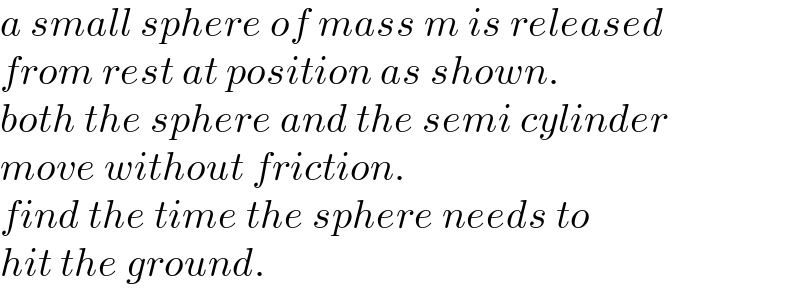
Question and Answers Forum
Question Number 131823 by mr W last updated on 09/Feb/21

Commented by mr W last updated on 10/Feb/21

Answered by mr W last updated on 09/Feb/21

Commented by mr W last updated on 10/Feb/21

Commented by mr W last updated on 10/Feb/21

Commented by mr W last updated on 09/Feb/21

Commented by mr W last updated on 11/Feb/21
![let ω=(dθ/dt), α=(dω/dt), μ=(M/m) x_Q =r+(R+r)cos θ V=(dx_Q /dt)=ω(dx_Q /dθ)=−(R+r)ω sin θ A=(dV/dt)=−(R+r)(α sin θ+ω^2 cos θ) y_P =(R+r)sin θ v=−(dy_P /dt)=−ω(dy_P /dθ)=−(R+r)ω cos θ a=(dv/dt)=−(R+r)(α cos θ−ω^2 sin θ) ((MV^2 +mv^2 )/2)=mg(R+r)(sin θ_0 −sin θ) (M/m)V^2 +v^2 =2g(R+r)(sin θ_0 −sin θ) [(M/m) sin^2 θ+ cos^2 θ]ω^2 (R+r)^2 =2g(R+r)(sin θ_0 −sin θ) ⇒ω^2 =((2g)/(R+r))×((sin θ_0 −sin θ)/(μ sin^2 θ+ cos^2 θ)) N cos θ=MA ⇒N=−((M(R+r))/(cos θ))(α sin θ+ω^2 cos θ) mg−N sin θ=ma N=((m(g−a))/(sin θ)) ⇒N=((m(R+r))/(sin θ))((g/(R+r))+α cos θ−ω^2 sin θ) ((m(R+r))/(sin θ))((g/(R+r))+α cos θ−ω^2 sin θ)=−((M(R+r))/(cos θ))(α sin θ+ω^2 cos θ) (g/(R+r))+α cos θ−ω^2 sin θ=−((μsin θ)/(cos θ))(α sin θ+ω^2 cos θ) α=−((cos θ)/(μsin^2 θ+cos^2 θ))[(g/(R+r))+(μ−1)sin θ ω^2 ] ⇒α=−(g/(R+r))×((cos θ)/(μsin^2 θ+cos^2 θ))[1+((2(μ−1)sin θ (sin θ_0 −sin θ))/(μ sin^2 θ+ cos^2 θ))] ⇒N=−M(R+r)(((sin θ)/(cos θ))α+ω^2 ) ⇒N=Mg{((sin θ)/(μ sin^2 θ+cos^2 θ))[1+((2(μ−1)sin θ (sin θ_0 −sin θ))/(μ sin^2 θ+ cos^2 θ))]−((2(sin θ_0 −sin θ))/(μ sin^2 θ+ cos^2 θ))} ⇒(N/(mg))=(μ/(μ sin^2 θ+cos^2 θ))[sin θ−((2(sin θ_0 −sin θ))/(μ sin^2 θ+ cos^2 θ))] say N=0 at θ=θ_2 . N=0 ⇒ sin θ−((2(sin θ_0 −sin θ))/(μ sin^2 θ+ cos^2 θ))=0 sin θ=((2(sin θ_0 −sin θ))/((μ−1) sin^2 θ+1)) sin^3 θ+(3/(μ−1)) sin θ−(2/(μ−1)) sin θ_0 =0 if μ=1: 3 sin θ−2 sin θ_0 =0 ⇒sin θ=(2/3) sin θ_0 ⇒θ_2 =sin^(−1) (((2 sin θ_0 )/3)) for μ≠1: let λ=(1/(μ−1))=(m/(M−m)) sin^3 θ+3λ sin θ−2λ sin θ_0 =0 Δ=λ^3 +λ^2 sin^2 θ_0 =λ^2 (λ+sin^2 θ_0 ) for λ+sin^2 θ_0 =(1/(μ−1))+sin^2 θ_0 >0, i.e. for μ>1: sin θ=((λ((√(λ+sin^2 θ_0 ))+sin θ_0 )))^(1/3) −((λ((√(λ+sin^2 θ_0 ))−sin θ_0 )))^(1/3) ⇒θ_2 =sin^(−1) [(((1/(μ−1))((√((1/(μ−1))+sin^2 θ_0 ))+sin θ_0 )))^(1/3) −(((1/(μ−1))((√((1/(μ−1))+sin^2 θ_0 ))−sin θ_0 )))^(1/3) ] for μ<1: sin θ=(2/( (√(1−μ)))) sin [(1/3)sin^(−1) ((√(1−μ)) sin θ_0 )+((2kπ)/3)] ⇒θ_2 =sin^(−1) {(2/( (√(1−μ)))) sin [(1/3)sin^(−1) ((√(1−μ)) sin θ_0 )]} we get θ_2 >θ_1 ,see diagram. that means the sphere losses contact before it hits the ground. after this point the sphere has free fall. T_1 = time for θ from θ_0 to θ_2 T_2 = time for free fall after θ_2 ⇒ω=(dθ/dt)=−(√((2g)/(R+r)))×(√((sin θ_0 −sin θ)/(μ sin^2 θ+ cos^2 θ))) ⇒T_1 =(√((R+r)/(2g)))∫_θ_2 ^θ_0 (√((1+(μ−1) sin^2 θ)/(sin θ_0 −sin θ)))dθ v=(√(2g(R+r)))×cos θ(√((sin θ_0 −sin θ)/(μ sin^2 θ+ cos^2 θ))) v_2 =(√(2g(R+r)))×cos θ_2 (√((sin θ_0 −sin θ_2 )/(μ sin^2 θ_2 + cos^2 θ_2 ))) Δh=(R+r)sin θ_2 −r Δh=v_2 T_2 +(1/2)gT_2 ^2 T_2 =(1/g)((√(v_2 ^2 +2gΔh))−v_2 ) total time: T=T_1 +T_2](Q131846.png)
Commented by mr W last updated on 10/Feb/21

Commented by mr W last updated on 10/Feb/21

Commented by otchereabdullai@gmail.com last updated on 10/Feb/21

Commented by otchereabdullai@gmail.com last updated on 10/Feb/21

Commented by mr W last updated on 10/Feb/21

Commented by ajfour last updated on 10/Feb/21

Commented by mr W last updated on 10/Feb/21

Commented by mr W last updated on 11/Feb/21

